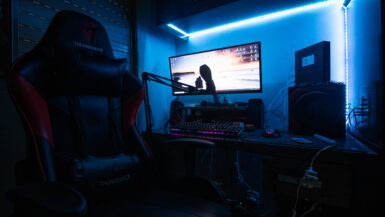As the world of smart home technology continues to expand and evolve, one of the most sought-after features is the ability to control home lighting with just your voice. The convenience and comfort of adjusting your home’s ambiance without lifting a finger have made voice-enabled lighting a popular choice for homeowners seeking to upgrade their living spaces. In this comprehensive guide, we will delve into the essential steps to set up voice control for your smart home’s lighting system. We will explore various voice-enabled smart home devices and assistants, discuss compatibility with different lighting products, and provide step-by-step instructions to create a seamless and user-friendly experience. So, let us embark on this illuminating journey towards a brighter and smarter home, controlled effortlessly by the power of your voice.
Choosing the Right Voice Assistant for Smart Home Lighting
As you begin your journey to integrate voice control into your smart home’s lighting system, the first crucial step is selecting the right voice assistant. With multiple options available in the market, it’s essential to understand their key features, compatibility with smart lighting devices, and the user experience they offer. In this section, we will compare popular voice assistants and outline their strengths and weaknesses to help you make an informed decision.
Amazon Alexa: The Market Leader
A popular choice among smart home users, Amazon Alexa offers wide compatibility with various smart lighting brands and devices. Its vast ecosystem of compatible products and its ability to create custom routines and control groups of lights make it a versatile and user-friendly option. However, please note that some features may require a subscription to Amazon Prime or additional purchases of compatible hardware, such as the Amazon Echo.
Google Assistant: The Smart Contender
Google Assistant is another strong contender in the voice assistant arena, offering a seamless experience with Google Home devices and a growing list of compatible smart lighting products. Its strength lies in its ability to understand natural language commands and provide contextual information. While Google Assistant’s compatibility may not be as extensive as Alexa, it’s known for its superior voice recognition and integration with other Google services.
Apple HomeKit and Siri: The Privacy Focused
For Apple users, Siri and HomeKit are the go-to options for voice-controlled smart home lighting. With a focus on privacy and data security, Apple’s ecosystem offers a seamless experience for those heavily invested in their products. However, HomeKit’s compatibility is more limited compared to its competitors, and its setup process may be more complex for certain devices. If privacy is a top concern and you’re an Apple user, this might be the best choice for you.
Microsoft Cortana: The Underdog
Though not as widely recognized as the other voice assistants, Microsoft’s Cortana still brings some unique features to the table. Its compatibility with smart lighting devices is limited, but Cortana offers integration with Microsoft services and the ability to control your lighting using a Windows PC. This option may be more suitable for those already immersed in the Microsoft ecosystem and seeking a simple solution for voice-controlled lighting.
Ultimately, your choice of voice assistant will depend on your personal preferences, existing devices, and the level of integration and customization you desire. By understanding the strengths and weaknesses of each option, you can confidently choose the right voice assistant to create a seamless and enjoyable lighting experience in your smart home.
Compatible Smart Lighting Devices and Voice Controllers
Once you have selected the right voice assistant for your smart home lighting system, it’s essential to choose compatible smart lighting devices and voice controllers. In this subsection, we will discuss popular smart lighting products and their compatibility with various voice assistants. We will also outline critical factors to consider when selecting your devices and controllers, ensuring that your voice-controlled lighting system functions efficiently and harmoniously.
Philips Hue: A Comprehensive Ecosystem
Philips Hue is a popular choice among smart home enthusiasts due to its extensive range of smart lighting products and compatibility with various voice assistants, including Amazon Alexa, Google Assistant, and Apple HomeKit. With color-changing bulbs, light strips, and smart switches, Philips Hue offers a comprehensive lighting solution that can be easily controlled with voice commands. Just keep in mind that you will need a Philips Hue Bridge to connect your lights to your voice assistant.
LIFX: No Hub Required
LIFX smart bulbs offer a wide range of colors and white shades, and they can be directly connected to your Wi-Fi network without requiring a hub. They are compatible with Amazon Alexa, Google Assistant, and Apple HomeKit, making them a versatile choice for various voice-enabled smart home systems. LIFX also offers light strips and tiles, providing additional options for creative lighting setups.
Yeelight: Affordable and Feature-Rich
Yeelight offers a range of affordable smart lighting products, including bulbs, light strips, and lamps. These devices are compatible with Amazon Alexa and Google Assistant. Although they are not officially supported by Apple HomeKit, some workarounds can be implemented to integrate Yeelight products into a HomeKit setup. Yeelight’s feature-rich app and wide range of products make it an attractive option for budget-conscious smart home enthusiasts.
TP-Link Kasa: Simple and Reliable
TP-Link’s Kasa lineup of smart lighting devices includes smart plugs, switches, and bulbs that can be controlled via voice commands using Amazon Alexa and Google Assistant. While Kasa products do not officially support Apple HomeKit, third-party solutions are available to integrate them into a HomeKit environment. Kasa devices are known for their simplicity and reliability, making them a strong contender in the smart lighting market.
Factors to Consider When Choosing Smart Lighting Devices
As you explore the various smart lighting devices and voice controllers compatible with your chosen voice assistant, consider factors such as ease of installation, product features, and price. You may also want to evaluate the manufacturer’s commitment to updates and improvements, as well as customer reviews and testimonials. By carefully considering these factors, you can confidently select smart lighting devices and voice controllers that will create an efficient, enjoyable, and cohesive voice-controlled lighting experience in your smart home.
Step-by-Step Guide to Setting Up Voice Control for Lights
Now that you have chosen your preferred voice assistant and compatible smart lighting devices, it’s time to set up voice control for your smart home’s lighting system. This process can vary slightly depending on the specific devices and voice assistant you have selected. However, the steps outlined in this section will provide a general overview for a smooth and successful setup. We will delve into the initial setup, integration of devices, and customization of voice commands, guiding you every step of the way to achieve an efficient and user-friendly voice-controlled lighting system.
Initial Setup: Voice Assistant and Smart Lighting Devices
Before integrating your smart lighting devices with your voice assistant, ensure that both are set up correctly. For your voice assistant, this may involve installing the corresponding app on your smartphone and following the setup instructions for your chosen smart speaker or display (e.g., Amazon Echo, Google Home, or Apple HomePod). For your smart lighting devices, carefully follow the manufacturer’s instructions to install and configure them properly. This may include connecting the devices to your Wi-Fi network, setting up a hub (if required), and installing any necessary apps.
Linking Your Smart Lighting Devices to Your Voice Assistant
Once your voice assistant and smart lighting devices are set up, it’s time to connect them. This process usually involves adding a “skill” or “service” within your voice assistant’s app. For example, if you’re using Amazon Alexa, navigate to the Skills & Games section in the Alexa app and search for your smart lighting brand (e.g., Philips Hue or LIFX). Similarly, for Google Assistant users, head to the Google Home app and tap on Add > Set up device > Works with Google, then search for your smart lighting brand. Apple HomeKit users can simply scan the HomeKit code provided with their smart lighting devices or manually enter the code within the Home app.
Discovering and Organizing Your Smart Lights
Once your smart lighting devices are linked to your voice assistant, it’s essential to ensure your voice assistant can discover and recognize them. This may involve asking your voice assistant to “discover devices” or using the corresponding app to search for new devices. Once discovered, you can assign names to each light (e.g., “Living Room Lamp” or “Kitchen Ceiling Light”) and organize them into groups or rooms for more efficient voice control.
Customizing Voice Commands and Creating Routines
With your smart lighting devices connected and organized, you can now begin customizing voice commands to control your lights. Experiment with different phrases and commands to find what works best for you. You can also create routines or scenes within your voice assistant’s app to automate specific lighting settings based on time, triggers, or events. For example, you might create a “Good Morning” routine that gradually increases the brightness of your bedroom lights when your morning alarm goes off.
Testing and Troubleshooting
Finally, test your voice-controlled lighting system by issuing various commands and ensuring your devices respond accordingly. If you encounter any issues, refer to the troubleshooting guides provided by your smart lighting manufacturer and voice assistant provider. Common issues may include Wi-Fi connectivity, device compatibility, or incorrect voice command phrasing.
By following this step-by-step guide, you can confidently set up voice control for your smart home’s lighting system and enjoy the convenience and comfort that come with voice-activated illumination. Experiment with different commands and routines to create a truly personalized and enjoyable lighting experience in your smart home.
Tips for Personalizing and Optimizing Voice Commands
Setting up voice control for your smart home’s lighting is just the beginning of creating a truly personalized and efficient experience. To fully harness the power of voice commands and make your smart lighting system even more user-friendly, it’s essential to explore customization options and optimize your voice commands. In this section, we will share tips and tricks for personalizing and refining your voice commands, ensuring that you get the most out of your voice-controlled lighting system.
Choose Descriptive and Memorable Names for Your Lights
To make it easier to control your smart lights using voice commands, assign descriptive and memorable names to each light. Instead of generic names like “Light 1” or “Light 2,” use names that reflect the light’s location or function, such as “Bedroom Lamp” or “Kitchen Pendant.” This will help your voice assistant better understand your commands, and you will remember the names more easily when issuing voice commands.
Organize Your Lights into Groups and Rooms
Grouping your smart lights into rooms or functional groups can make voice control more efficient and intuitive. For example, instead of controlling each light individually, you can issue commands like “Turn off all living room lights” or “Dim the dining room lights to 50%.” Organize your lights within your voice assistant’s app, ensuring that each light is assigned to the appropriate group or room for optimal voice control.
Experiment with Different Command Phrases
Voice assistants can understand a wide variety of command phrases, so don’t be afraid to experiment and find the phrases that work best for you. For example, instead of saying “Turn on the bedroom light,” you might try “Illuminate the bedroom” or “Brighten up the bedroom.” Experiment with different phrases and commands to find the most natural and efficient way to control your smart lights with your voice.
Create Custom Routines and Scenes
Custom routines and scenes can significantly enhance your voice-controlled lighting experience by automating specific settings based on triggers, events, or time of day. Use your voice assistant’s app to create custom routines, such as a “Movie Night” scene that dims the living room lights and turns on the accent lighting, or a “Good Morning” routine that gently increases the brightness of your bedroom lights when your alarm goes off. These personalized routines will make voice control even more convenient and enjoyable.
Adjust Voice Assistant Settings for Better Voice Recognition
If you find that your voice assistant has difficulty understanding your commands, consider adjusting its settings to improve voice recognition. Many voice assistants allow you to adjust sensitivity, train the assistant to better recognize your voice, or even change the language or accent of the assistant. Fine-tuning these settings can lead to a more accurate and efficient voice-controlled lighting experience.
By personalizing and optimizing your voice commands, you can create a truly seamless and enjoyable voice-controlled lighting experience in your smart home. Take the time to experiment and refine your commands, routines, and settings to harness the full potential of your voice-controlled lighting system.
Troubleshooting Common Issues with Voice-Controlled Lighting
As you venture into the world of voice-controlled lighting, it’s not uncommon to encounter some issues or challenges. In this subsection, we will address common problems experienced by users and provide practical solutions to help you overcome any obstacles you may face in your journey to create a seamless and efficient voice-controlled lighting system in your smart home.
Issue 1: Voice Assistant Not Responding to Commands
One of the most common issues with voice-controlled lighting is when the voice assistant doesn’t respond to your commands. This can occur for various reasons, such as a weak Wi-Fi connection, an incorrect command phrase, or a misconfigured device. To resolve this issue, try the following:
- Ensure your voice assistant and smart lighting devices are connected to a stable Wi-Fi network.
- Double-check your command phrasing and experiment with different phrases if necessary.
- Verify that your smart lighting devices are correctly set up and connected to your voice assistant.
- Adjust your voice assistant’s settings to improve voice recognition, such as sensitivity or voice training.
Issue 2: Inability to Control Specific Lights or Groups
Sometimes, users may struggle to control specific lights or groups of lights using voice commands. This problem may arise due to incorrect naming, device grouping, or compatibility issues. To tackle this issue, consider the following solutions:
- Ensure that your smart lights have descriptive and memorable names that are easily recognized by your voice assistant.
- Check that your lights are organized into appropriate groups or rooms within your voice assistant’s app.
- Confirm that your smart lighting devices are compatible with your chosen voice assistant and follow any necessary steps to link them correctly.
Issue 3: Difficulty in Executing Custom Routines or Scenes
Custom routines and scenes can greatly enhance your voice-controlled lighting experience, but sometimes they may not function as intended. This could result from incorrect setup, conflicting commands, or limitations in your voice assistant’s capabilities. To resolve these issues, try the following:
- Double-check the setup of your custom routines or scenes within your voice assistant’s app and ensure they are correctly configured.
- Avoid using conflicting commands or phrases that may confuse your voice assistant.
- Consult your voice assistant’s documentation or support resources to understand any limitations or restrictions in its ability to execute custom routines or scenes.
Issue 4: Inconsistency in Voice Command Recognition
In some cases, users may find that their voice assistant inconsistently recognizes voice commands for their smart lighting system. This can be frustrating and hinder the seamless experience you desire. To address this issue, consider the following tips:
- Ensure there is no background noise or interference when issuing voice commands.
- Speak clearly and enunciate your words to improve voice recognition.
- Adjust your voice assistant’s settings to improve voice recognition, such as sensitivity or voice training.
- Experiment with different command phrases to find the ones that work best with your voice assistant.
By addressing these common issues and implementing the suggested solutions, you can effectively troubleshoot any obstacles you may face in setting up your voice-controlled lighting system. With patience and persistence, you will soon enjoy the convenience and comfort of controlling your smart home’s lighting with just the sound of your voice.





Leave a reply